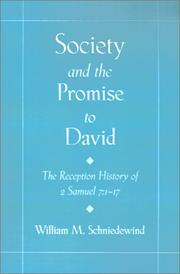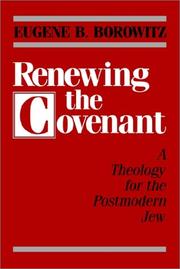| Listing 1 - 10 of 188 | << page >> |
Sort by
|
Book
Year: 2017 Publisher: [Place of publication not identified] : Great Neck Publishing,
Abstract | Keywords | Export | Availability | Bookmark
 Loading...
Loading...Choose an application
- Reference Manager
- EndNote
- RefWorks (Direct export to RefWorks)
Book
ISBN: 0567679128 056767911X Year: 2018 Publisher: New York Bloomsbury T&T Clark
Abstract | Keywords | Export | Availability | Bookmark
 Loading...
Loading...Choose an application
- Reference Manager
- EndNote
- RefWorks (Direct export to RefWorks)
An examination of the relationship between the Davidic covenant and Abrahamic and Mosaic covenants reflected in the editorial shape and shaping of the Masoretic Psalter. Hensley proposes that the editors of the Psalter understood these covenants as a theological unity, whose common fulfilment centres on an anticipated royal successor to David. To test this hypothesis Hensley examines the Psalter's references and allusions to covenant(s) in light of editorial evidence. The book is split into three parts. Part I reassesses different kinds of editorial evidence, their implications, and their utility for discerning editorial intent. It also re-evaluates the Qumran Psalms hypothesis championed by Sanders, Wilson, and others. Part II engages in extensive survey work on references and allusions to covenant(s) in the Psalter, assessing the extent to which they gravitate around David. Hensley traces phraseological and intertextual allusions to covenant promises and obligations, providing the first survey of its kind on the subject of covenant in the Psalter. Part III then investigates a strong allusion to the Abrahamic covenantal promises in Ps 72:17 in the context of Book II of the Psalter, and the Psalter's fullest echoes of the "grace formula" (Exod 34:6) in Psalm 86:15, 103:8, and 145:8 in the contexts of Books III, IV, and V respectively. Hensley shows that rather than the Davidic covenantal promises being "democratized," the promises and obligations of the pre-monarchic covenants are consistently "royalized" throughout the Psalter and its books, depicting the anticipated Davidic figure as a Moses-like intercessor and mediator of covenant renewal, and the leader of a "new song" for a "new exodus."
Covenants --- Biblical teaching. --- Bible. --- Criticism, Redaction.
Book
ISBN: 1498233562 9781498233569 1498233554 9781498233552 Year: 2015 Publisher: Eugene, Oregon Resource Publications
Abstract | Keywords | Export | Availability | Bookmark
 Loading...
Loading...Choose an application
- Reference Manager
- EndNote
- RefWorks (Direct export to RefWorks)
In the development of Covenant Works I follow neither the way of the seventeenth-century Federal Theology, nor the way of nineteenth-century Critical Theology, nor the way of twentieth-century Federal Vision, nor the way of a compromise. Covenant Works lays open the Scriptures' biblical structure.The author integrates the covenant, Christology, the trinity, the kingdom, the church, and historical linearity into the Scriptures to reveal its architectonic unity.
Covenants --- Biblical teaching. --- Covenant theology --- Biblical teaching
Book
ISBN: 056766516X 0567665151 Year: 2016 Publisher: New York Bloomsbury T&T Clark
Abstract | Keywords | Export | Availability | Bookmark
 Loading...
Loading...Choose an application
- Reference Manager
- EndNote
- RefWorks (Direct export to RefWorks)
The core of Malachi's covenantal imagination is shaped by his reflection on an authoritative collection of source texts in the Hebrew Bible. The mention of people, nations and places, Deuteronomic terminology, and rare words and unique word/root combinations exclusive to Malachi and only a few other texts encourages the book to be read in the context of received biblical traditions and texts. The diversity of methodologies used previously to analyse Malachi has resulted in confusion about the significance of the inner-biblical connections in the book of Malachi, which Gibson clarifies. His reading frees the text of Malachi from being overburdened by too many "intertexts", and allows its central message of covenant to arise with greater clarity and force. Gibson reveals how Malachi's connections to earlier source texts are neither random nor causal; rather, they have been strategically employed to inform and shape his central theme of covenant continuity and fidelity
Covenants --- Biblical teaching. --- Bible. --- Criticism, interpretation, etc.

ISBN: 1280831065 0195352068 9780195352061 0195126807 9780195126808 9786610831067 6610831068 0197741223 Year: 1999 Publisher: New York : Oxford University Press,
Abstract | Keywords | Export | Availability | Bookmark
 Loading...
Loading...Choose an application
- Reference Manager
- EndNote
- RefWorks (Direct export to RefWorks)
In the second book of Samuel, the prophet Nathan tells King David that God will give to him and his descendants a great and everlasting kingdom. In this study Schniedewind looks at how this dynastic Promise has been understood and transmitted from the time of its first appearance at the inception of the Hebrew monarchy until the dawn of Christianity. He shows in detail how, over the centuries, the Promise grew in importance and prestige. One measure of this growing importance was the Promise's ability to coax new readers into fresh interpretations.
Covenants --- Biblical teaching. --- Bible. --- Criticism, interpretation, etc. --- History.
Book
ISBN: 0674073711 0674073681 9780674073685 9780674072541 0674072545 9780674073715 Year: 2013 Publisher: Cambridge, Massachusetts
Abstract | Keywords | Export | Availability | Bookmark
 Loading...
Loading...Choose an application
- Reference Manager
- EndNote
- RefWorks (Direct export to RefWorks)
Saving the Neighborhood tells the charged, still controversial story of the rise and fall of racially restrictive covenants in America, and offers rare insight into the ways legal and social norms reinforce one another, acting with pernicious efficacy to codify and perpetuate intolerance. The early 1900's saw an unprecedented migration of African Americans leaving the rural South in search of better work and equal citizenship. In reaction, many white communities instituted property agreements-covenants-designed to limit ownership and residency according to race. Restrictive covenants quickly became a powerful legal guarantor of segregation, their authority facing serious challenge only in 1948, when the Supreme Court declared them legally unenforceable in Shelley v. Kraemer. Although the ruling was a shock to courts that had upheld covenants for decades, it failed to end their influence. In this incisive study, Richard Brooks and Carol Rose unpack why. At root, covenants were social signals. Their greatest use lay in reassuring the white residents that they shared the same goal, while sending a warning to would-be minority entrants: keep out. The authors uncover how loosely knit urban and suburban communities, fearing ethnic mixing or even "tipping," were fair game to a new class of entrepreneurs who catered to their fears while exacerbating the message encoded in covenants: that black residents threatened white property values. Legal racial covenants expressed and bestowed an aura of legitimacy upon the wish of many white neighborhoods to exclude minorities. Sadly for American race relations, their legacy still lingers.
Real covenants --- Discrimination in housing --- Covenants running with land --- Restrictive covenants --- Covenants (Law) --- Encumbrances (Law) --- Land titles --- Landlord and tenant --- Real property --- Vendors and purchasers --- Servitudes --- Law and legislation --- Registration and transfer
Book
ISBN: 9780567665140 0567665143 9780567665157 0567665151 9780567665164 056766516X Year: 2016 Publisher: London Bloomsbury T&T Clark
Abstract | Keywords | Export | Availability | Bookmark
 Loading...
Loading...Choose an application
- Reference Manager
- EndNote
- RefWorks (Direct export to RefWorks)
The core of Malachi's covenantal imagination is shaped by his reflection on an authoritative collection of source texts in the Hebrew Bible. The mention of people, nations and places, Deuteronomic terminology, and rare words and unique word/root combinations exclusive to Malachi and only a few other texts encourages the book to be read in the context of received biblical traditions and texts. The diversity of methodologies used previously to analyse Malachi has resulted in confusion about the significance of the inner-biblical connections in the book of Malachi, which Gibson clarifies. His reading frees the text of Malachi from being overburdened by too many "intertexts", and allows its central message of covenant to arise with greater clarity and force. Gibson reveals how Malachi's connections to earlier source texts are neither random nor causal; rather, they have been strategically employed to inform and shape his central theme of covenant continuity and fidelity
Covenants --- Biblical teaching --- Biblia --- Criticism, interpretation, etc. --- Biblical teaching. --- Bible.

ISBN: 082760985X 9780827609853 0827606273 9780827606272 Year: 1996 Publisher: Philadelphia, Pa. Jewish Publication Society
Abstract | Keywords | Export | Availability | Bookmark
 Loading...
Loading...Choose an application
- Reference Manager
- EndNote
- RefWorks (Direct export to RefWorks)
Judaism --- Commandments (Judaism) --- Covenants --- History of doctrines --- Religious aspects
Book
ISBN: 0779907566 Year: 2014 Publisher: Lewiston : The Edwin Mellen Press,
Abstract | Keywords | Export | Availability | Bookmark
 Loading...
Loading...Choose an application
- Reference Manager
- EndNote
- RefWorks (Direct export to RefWorks)
""Fredrickson's work is fresh, engaging and foundational for those who embrace the blessings of the New Covenant. His careful exegesis of the relevant new Covenant texts makes his book an especially helpful resource... this book would be warmly welcomed by biblical scholars, theologians and serious minded pastors. [It] is a significant contribution to the study of the New Covenant and the question of whether the New Covenant is referred to in Isaiah's Servant Songs.- Professor J. Carl Laney,Western Seminary, Oregon

ISBN: 077344565X 9780773445659 9780773442580 0773442588 0773442669 9780773442665 Year: 2014 Publisher: Lewiston, NY
Abstract | Keywords | Export | Availability | Bookmark
 Loading...
Loading...Choose an application
- Reference Manager
- EndNote
- RefWorks (Direct export to RefWorks)
A fresh investigation of all the texts of the Davidic covenant appearing in the book of Chronicles. The focus of this study is to examine the texts in an effort to understand why the Chronicler's view emphasized a hope of a postexilic restoration of the Davidic kingdom, rather than being content with the construction of the Temple and the revival of cultic sacrifices. This is an outstanding definitive work on this on-going theologically divisive subject.
Bible. Chronicles -- Criticism, interpretation, etc. --- Covenants -- Biblical teaching. --- David, King of Israel. --- Covenants --- Biblical teaching --- David, --- Bible. --- Criticism, interpretation, etc.
| Listing 1 - 10 of 188 | << page >> |
Sort by
|

 Search
Search Feedback
Feedback About UniCat
About UniCat  Help
Help News
News